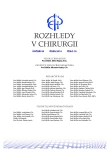-
Medical journals
- Career
Pilonidal sinus – possibilities surgical treatment
Authors: J. Örhalmi; O. Sotona; T. Dušek; A. Ferko
Authors‘ workplace: Chirurgická klinika Fakultní nemocnice Hradec Králové a Lékařské Fakulty UK v Hradci Králové přednosta kliniky: prof. MUDr. A. Ferko, CSc.
Published in: Rozhl. Chir., 2014, roč. 93, č. 10, s. 491-495.
Category: Original articles
Overview
Introduction:
Pilonidal sinus is a skin disease affecting the sacrococcygeal region caused by chronic irritation of the skin by ingrowing hairs that get pushed into skin sinuses and follicles. The acute form of the disease which is presented by subcutaneous abscesses very often develops into chronic suppurative subcutaneous fistula. The incidence of pilonidal sinus is approximately 26/100,000 people. Radical surgical excision using skin flaps is essential for successful treatment.Materials and methods:
The results of surgical treatment were analysed retrospectively. All surgical procedures evaluated were performed at the Department of Surgery, University Hospital in Hradec Kralove, from January 2010 to June 2014. The parameters analysed were gender, age, method used to close the defect, length of hospital stay, overall morbidity including pilonidal sinuses recurrence.Results:
141 patients undergoing radical excision for pilonidal sinus were analysed. Primary suture was used in 101 (71.6%) patients. Limberg flap reconstruction was performed in 16 (11.3%) patients and Karydakis procedure was used in 24 (17.0%) patients. The length of hospital stay was 4.2 days. 19 operations were performed for recurrent pilonidal sinus. Norecurrence occurred after Karydakis procedure, there were 3 cases of recurrence after Limberg flap reconstruction, and 8 patients experienced recurrence after primary suture. The overall incidence of recurrence was 7.8%. Surgical site complications were recorded mostly after primary suture (37 patients, 26.2%). Conversely, surgical site complications appeared in the Limberg flap group in 2 patients (12.5%) and in theKarydakis procedure group in 1 patient (4.2%).Conclusion:
Limberg flap reconstruction and Karydakis procedure lead to better results in pilonidal sinus surgery, especially as regards lower recurrence rates and overall morbidity. Both of these procedures are relatively easy to perform and technically undemanding.Key words:
pilonidal sinus – Limberg flap – Karydakis flap – excision
Sources
1. el-Khadrawy O, Ismail K. Outcome of the rhomboid flap for recurrent pilonidal disease. World J Surg 2009;33 : 1069−1073.
2. Horák L, Skřička T, Šlauf P, Örhalmi J. Praktická proktologie. Praha, Grada publishing 2013.
3. Kayaalp C, Aydin C. Review of phenol treatment in sacrococcygeal pilonidal disease. Techniques in Coloproctology 2009;13 : 189–193.
4. Giamundo P, Geraci M, Tibaldi L. Closure of fistula-in-ano with laser-FiLaC™: an effective novel sphincter-saving procedure for complex disease. Colorectal Dis 2014;16 : 110−115.
5. Meinero P, Mori L, Gasloli G. Endoscopic pilonidal sinus treatment (E.P.Si.T.). Techniques in Coloproctology 2014;18 : 389−392.
6. Bessa S. Comparison of short-term results between the modified Karydakis flap and the modified Limberg flap in the management of pilonidal sinus disease: A randomized controlled study. Dis Colon Rectum 2013;56 : 491–498.
7. Anderson, JH, Yip Ch, Nagabhushan JS, Conelly S. Day-case Karydakis flap for pilonidal sinus. Dis Colon Rectum 2008;51 : 134−138.
8. Okuş A, Sevinç B, Karahan O, Eryılmaz MA. Comparison of Limberg flap and tension-free primary closure during pilonidal sinus surgery. World J Surg 2011;36 : 431−5.
9. Unalp HR, Derici H, Kamer E. Lower recurrence rate for Limberg vs. V-Y flap for pilonidal sinus. Dis Colon Rectum 2007;50 : 1436–1444.
10. Müller K, Marti L,Tarantino I, et al. Prospective analysis of cosmetic, morbidity, and patient satisfaction following Limberg flap for the treatment of sacrococcygeal pilonidal sinus. Dis Colon Rectum 2011;54 : 487–494.
11. Šmíd D, Novák P, Liška, V, Třeška V. Pilonidální sinus – chirurgická léčba na našem pracovišti. Rozhl Chir 2011;90 : 301,305.
Labels
Surgery Orthopaedics Trauma surgery
Article was published inPerspectives in Surgery

2014 Issue 10-
All articles in this issue
- Pilonidal sinus – possibilities surgical treatment
- Sinus pilonidalis – possibilities of surgical treatment
- Laparoscopic parastomal hernia repair with modified Sugarbaker technique in patients after abdominoperineal resection of the rectum – initial experience
- Why are carotid glomus tumours dangerous?
- Metachronous lung metastases of mammary carcinoma, or dual malignancy? A surgeon’s and oncologist’s point of view − case report
- Current status of sentinel lymph node biopsy in patients with melanoma
- Pylephlebitis in patient with covered perforated rectosigmoid cancer
- Perspectives in Surgery
- Journal archive
- Current issue
- Online only
- About the journal
Most read in this issue- Pilonidal sinus – possibilities surgical treatment
- Sinus pilonidalis – possibilities of surgical treatment
- Why are carotid glomus tumours dangerous?
- Laparoscopic parastomal hernia repair with modified Sugarbaker technique in patients after abdominoperineal resection of the rectum – initial experience
Login#ADS_BOTTOM_SCRIPTS#Forgotten passwordEnter the email address that you registered with. We will send you instructions on how to set a new password.
- Career

